-
 Bitcoin
Bitcoin $105,953.9980
3.06% -
 Ethereum
Ethereum $2,445.3292
6.68% -
 Tether USDt
Tether USDt $1.0006
-0.03% -
 XRP
XRP $2.1968
7.03% -
 BNB
BNB $643.2903
2.13% -
 Solana
Solana $144.2799
3.82% -
 USDC
USDC $1.0000
-0.03% -
 TRON
TRON $0.2739
0.49% -
 Dogecoin
Dogecoin $0.1642
4.47% -
 Cardano
Cardano $0.5834
5.49% -
 Hyperliquid
Hyperliquid $38.0741
2.80% -
 Sui
Sui $2.7741
7.56% -
 Chainlink
Chainlink $13.4107
11.26% -
 Bitcoin Cash
Bitcoin Cash $450.4828
-0.61% -
 UNUS SED LEO
UNUS SED LEO $9.1301
0.64% -
 Stellar
Stellar $0.2476
5.49% -
 Avalanche
Avalanche $18.0637
5.09% -
 Toncoin
Toncoin $2.9066
2.43% -
 Shiba Inu
Shiba Inu $0.0...01160
4.01% -
 Hedera
Hedera $0.1527
8.00% -
 Litecoin
Litecoin $84.6122
2.37% -
 Monero
Monero $317.6076
5.76% -
 Ethena USDe
Ethena USDe $1.0008
0.02% -
 Polkadot
Polkadot $3.4519
5.27% -
 Dai
Dai $1.0000
-0.03% -
 Bitget Token
Bitget Token $4.2835
5.62% -
 Uniswap
Uniswap $7.0443
9.78% -
 Pepe
Pepe $0.0...09964
7.41% -
 Pi
Pi $0.5391
4.64% -
 Aave
Aave $264.1743
11.26%
How to operate when EMA diverges from price?
When EMA diverges from price, identify bullish or bearish signals, interpret their strength and market context, then execute trades with clear entry, stop-loss, and take-profit levels.
May 22, 2025 at 09:35 pm
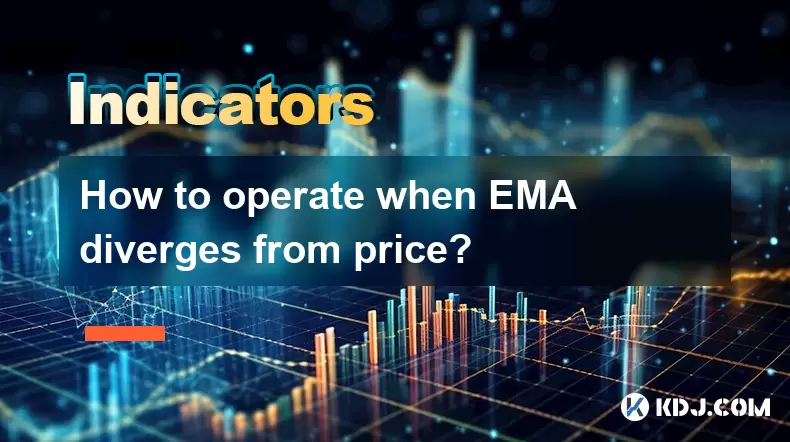
When the Exponential Moving Average (EMA) diverges from the price, it can signal potential trading opportunities or a change in market trends. Understanding how to operate in such scenarios is crucial for traders looking to capitalize on these signals. This article will guide you through the process of identifying EMA divergence from price, interpreting these signals, and executing trades based on these observations.
Identifying EMA Divergence
The first step in operating when EMA diverges from price is to accurately identify the divergence. EMA divergence occurs when the price of an asset moves in the opposite direction of the EMA. There are two main types of divergence to consider: bullish divergence and bearish divergence.
- Bullish Divergence happens when the price of the asset forms lower lows, but the EMA forms higher lows. This indicates that the downward momentum is weakening, and a potential upward reversal may be on the horizon.
- Bearish Divergence is the opposite, occurring when the price forms higher highs, but the EMA forms lower highs. This suggests that the upward momentum is fading, and a potential downward reversal could be imminent.
To identify these divergences, traders should:
- Use charting software that supports the plotting of EMAs.
- Select an appropriate EMA period, such as the 12-day or 26-day EMA, depending on the trading timeframe.
- Observe the price action and compare it to the EMA's movements over time.
Interpreting EMA Divergence
Once the divergence is identified, the next step is to interpret what it means for potential trading opportunities. Interpreting EMA divergence requires understanding the context of the market and the strength of the divergence.
- Strength of Divergence: The more pronounced the divergence, the stronger the signal. A slight divergence might not be as reliable as a significant one.
- Market Context: Consider the overall market trend and other technical indicators to confirm the divergence signal. For instance, if the market is in a strong uptrend, a bearish divergence might be more significant than if the market were in a downtrend.
Traders should also look for confirmation from other indicators, such as the Relative Strength Index (RSI) or the Moving Average Convergence Divergence (MACD), to validate the divergence signal.
Executing Trades Based on EMA Divergence
Once the divergence is identified and interpreted, traders can proceed to execute trades based on these signals. Executing trades involves setting up entry points, stop-loss levels, and take-profit targets.
- Entry Points: For bullish divergence, consider entering a long position when the price breaks above a recent high or a resistance level. For bearish divergence, enter a short position when the price breaks below a recent low or a support level.
- Stop-Loss Levels: Set stop-loss orders just below the most recent low for long positions or above the most recent high for short positions to manage risk.
- Take-Profit Targets: Determine take-profit levels based on previous resistance or support levels or using a risk-reward ratio, such as 2:1 or 3:1.
Here’s a detailed step-by-step guide for executing trades:
For Bullish Divergence:
- Identify the bullish divergence on the chart.
- Wait for the price to break above a recent high or resistance level.
- Enter a long position at the breakout point.
- Place a stop-loss order just below the most recent low.
- Set take-profit levels at previous resistance levels or based on a favorable risk-reward ratio.
For Bearish Divergence:
- Identify the bearish divergence on the chart.
- Wait for the price to break below a recent low or support level.
- Enter a short position at the breakdown point.
- Place a stop-loss order just above the most recent high.
- Set take-profit levels at previous support levels or based on a favorable risk-reward ratio.
Monitoring and Adjusting Trades
After entering a trade based on EMA divergence, it's essential to monitor and adjust the trade as market conditions change. This involves keeping an eye on the price action and other technical indicators to ensure the trade remains valid.
- Price Action: Continuously monitor the price to see if it continues to move in the expected direction. If the price starts to move against the trade, consider adjusting the stop-loss to minimize losses.
- Other Indicators: Use additional indicators like the RSI or MACD to confirm the divergence signal remains strong. If these indicators start to show conflicting signals, it may be time to exit the trade.
Common Pitfalls and How to Avoid Them
When operating based on EMA divergence, traders should be aware of common pitfalls and how to avoid them. One of the most common mistakes is acting on weak divergence signals without confirmation from other indicators. To avoid this, always use multiple indicators to validate the divergence.
Another pitfall is entering trades too early or too late. To mitigate this, wait for clear breakouts or breakdowns before entering a trade. Additionally, ensure that the stop-loss and take-profit levels are set appropriately to manage risk effectively.
Frequently Asked Questions
Q: Can EMA divergence be used as a standalone indicator for trading?
A: While EMA divergence can provide valuable insights into potential trend reversals, it is generally more effective when used in conjunction with other technical indicators. Relying solely on EMA divergence might lead to false signals, so it's best to use it as part of a broader trading strategy.
Q: How often should I check for EMA divergence on my charts?
A: The frequency of checking for EMA divergence depends on your trading timeframe. For day traders, checking charts every few minutes or hours might be necessary. Swing traders might check daily or weekly charts. It's important to align the frequency with your trading strategy and timeframe.
Q: What EMA periods are best for identifying divergence?
A: The choice of EMA period depends on the trading timeframe. Shorter periods like the 12-day EMA are suitable for short-term trading, while longer periods like the 26-day or 50-day EMA are better for medium to long-term trading. Experiment with different periods to find what works best for your strategy.
Q: How do I handle false signals from EMA divergence?
A: False signals are a common challenge in trading. To handle them, always use confirmation from other indicators and wait for clear price action before entering trades. Additionally, setting appropriate stop-loss levels can help minimize losses from false signals.
Disclaimer:info@kdj.com
The information provided is not trading advice. kdj.com does not assume any responsibility for any investments made based on the information provided in this article. Cryptocurrencies are highly volatile and it is highly recommended that you invest with caution after thorough research!
If you believe that the content used on this website infringes your copyright, please contact us immediately (info@kdj.com) and we will delete it promptly.
- Cryptocurrencies: Chart-Breaking Buys Beyond the Hype
- 2025-06-25 04:45:12
- Navigating Crypto Volatility: UNI Price, SUI Token, and the Rise of Unstaked
- 2025-06-25 04:45:12
- Bitcoin, Ethereum, and Geopolitical Tensions: Navigating the Iran-Israel Ceasefire
- 2025-06-25 05:05:13
- JPMorgan, Blockchain, and JPMD Token: A Quantum Leap for On-Chain Finance?
- 2025-06-25 05:05:13
- Bitcoin Desktop Wallets in 2025: A New Yorker's Take
- 2025-06-25 04:25:13
- Coinbase Stock Jumps: Decoding the Reasons Behind the Surge
- 2025-06-25 04:25:13
Related knowledge
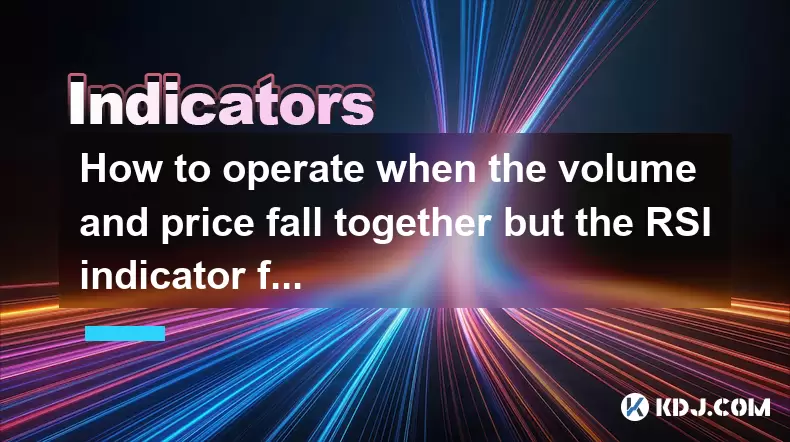
How to operate when the volume and price fall together but the RSI indicator forms a bottom divergence?
Jun 25,2025 at 04:29am
Understanding the Concept of RSI Bottom DivergenceWhen analyzing cryptocurrency price charts, traders often rely on technical indicators to spot potential reversals. One such signal is a bottom divergence in the Relative Strength Index (RSI). This occurs when the price makes a new low, but the RSI does not confirm that low and instead forms a higher low...
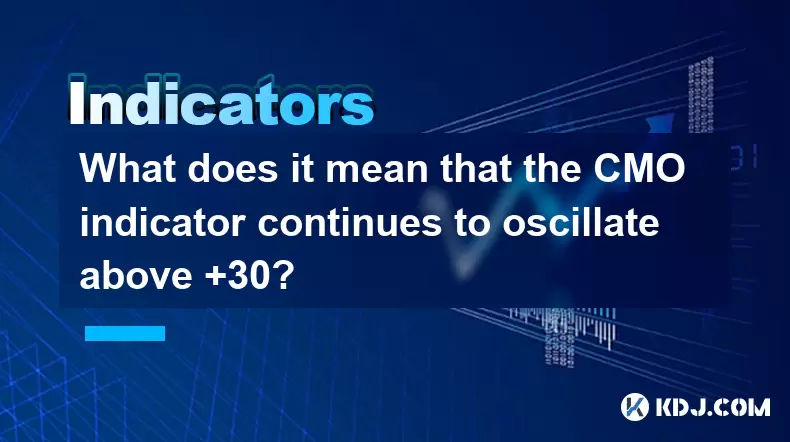
What does it mean that the CMO indicator continues to oscillate above +30?
Jun 25,2025 at 03:29am
Understanding the CMO IndicatorThe Chande Momentum Oscillator (CMO) is a technical analysis tool developed by Tushar Chande to measure momentum in financial markets. In cryptocurrency trading, the CMO helps traders identify overbought or oversold conditions and potential trend reversals. The oscillator ranges from -100 to +100, with values above zero in...

What does it mean that the ATR indicator suddenly doubles after hitting a new low this year?
Jun 24,2025 at 11:57pm
Understanding the ATR IndicatorThe Average True Range (ATR) is a technical analysis indicator used to measure market volatility. Developed by J. Welles Wilder, ATR calculates the average price range between a security’s high and low over a specific period—typically 14 periods. It does not indicate the direction of price movement but rather how volatile ...
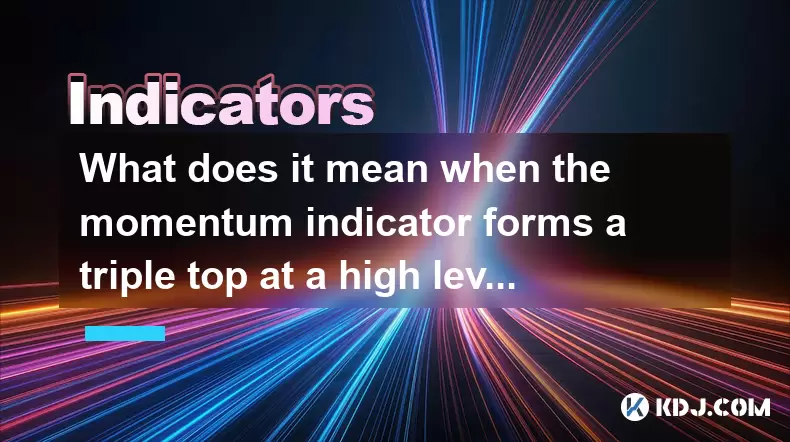
What does it mean when the momentum indicator forms a triple top at a high level?
Jun 25,2025 at 03:15am
Understanding the Momentum Indicator in Cryptocurrency TradingThe momentum indicator is a widely used technical analysis tool that measures the rate of change in price movements over a specified period. In cryptocurrency trading, where volatility is high and trends can reverse rapidly, this indicator helps traders identify potential trend reversals or c...
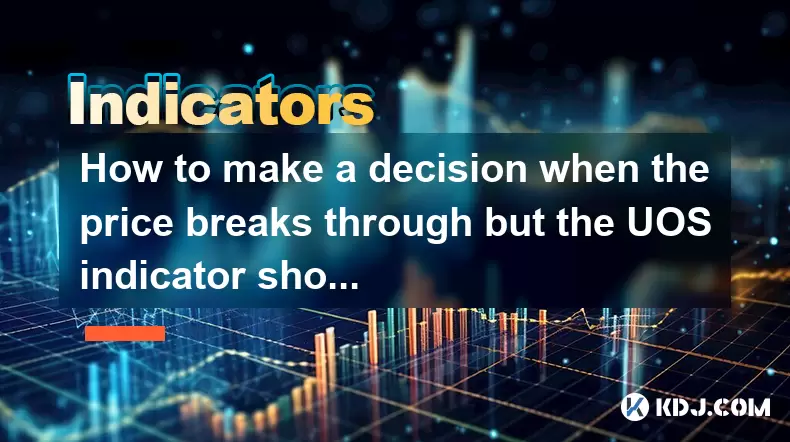
How to make a decision when the price breaks through but the UOS indicator shows a top divergence?
Jun 24,2025 at 11:42pm
Understanding the UOS Indicator and Price BreakthroughsThe Ultimate Oscillator (UOS) is a momentum oscillator that combines multiple timeframes to provide a more accurate picture of market momentum. When traders observe a price breakthrough — where the price moves above a key resistance level — but the UOS indicator shows a top divergence, it creates a ...

How to interpret the stochastic indicator being blunted for 5 consecutive days in the overbought area?
Jun 25,2025 at 03:00am
Understanding the Stochastic Indicator in Cryptocurrency TradingThe stochastic indicator is a momentum oscillator widely used in technical analysis within the cryptocurrency market. It helps traders identify overbought and oversold conditions by comparing a particular closing price of an asset to a range of its prices over a certain period. The standard...

How to operate when the volume and price fall together but the RSI indicator forms a bottom divergence?
Jun 25,2025 at 04:29am
Understanding the Concept of RSI Bottom DivergenceWhen analyzing cryptocurrency price charts, traders often rely on technical indicators to spot potential reversals. One such signal is a bottom divergence in the Relative Strength Index (RSI). This occurs when the price makes a new low, but the RSI does not confirm that low and instead forms a higher low...

What does it mean that the CMO indicator continues to oscillate above +30?
Jun 25,2025 at 03:29am
Understanding the CMO IndicatorThe Chande Momentum Oscillator (CMO) is a technical analysis tool developed by Tushar Chande to measure momentum in financial markets. In cryptocurrency trading, the CMO helps traders identify overbought or oversold conditions and potential trend reversals. The oscillator ranges from -100 to +100, with values above zero in...

What does it mean that the ATR indicator suddenly doubles after hitting a new low this year?
Jun 24,2025 at 11:57pm
Understanding the ATR IndicatorThe Average True Range (ATR) is a technical analysis indicator used to measure market volatility. Developed by J. Welles Wilder, ATR calculates the average price range between a security’s high and low over a specific period—typically 14 periods. It does not indicate the direction of price movement but rather how volatile ...

What does it mean when the momentum indicator forms a triple top at a high level?
Jun 25,2025 at 03:15am
Understanding the Momentum Indicator in Cryptocurrency TradingThe momentum indicator is a widely used technical analysis tool that measures the rate of change in price movements over a specified period. In cryptocurrency trading, where volatility is high and trends can reverse rapidly, this indicator helps traders identify potential trend reversals or c...

How to make a decision when the price breaks through but the UOS indicator shows a top divergence?
Jun 24,2025 at 11:42pm
Understanding the UOS Indicator and Price BreakthroughsThe Ultimate Oscillator (UOS) is a momentum oscillator that combines multiple timeframes to provide a more accurate picture of market momentum. When traders observe a price breakthrough — where the price moves above a key resistance level — but the UOS indicator shows a top divergence, it creates a ...

How to interpret the stochastic indicator being blunted for 5 consecutive days in the overbought area?
Jun 25,2025 at 03:00am
Understanding the Stochastic Indicator in Cryptocurrency TradingThe stochastic indicator is a momentum oscillator widely used in technical analysis within the cryptocurrency market. It helps traders identify overbought and oversold conditions by comparing a particular closing price of an asset to a range of its prices over a certain period. The standard...
See all articles
























































































